�
Multiple Attribute
Decision Making
M e t h o d s a n d a p p l i c a t i o n s
�
Multiple Attribute
Decision Making
M e t h o d s a n d a p p l i c a t i o n s
Gwo-Hshiung Tzeng
Jih-Jeng Huang
�
CRC Press
Taylor & Francis Group
6000 Broken Sound Parkway NW, Suite 300
Boca Raton, FL 33487-2742
© 2011 by Taylor & Francis Group, LLC
CRC Press is an imprint of Taylor & Francis Group, an Informa business
No claim to original U.S. Government works
Printed in the United States of America on acid-free paper
Version Date: 20110513
International Standard Book Number: 978-1-4398-6157-8 (Hardback)
This book contains information obtained from authentic and highly regarded sources. Reasonable
efforts have been made to publish reliable data and information, but the author and publisher cannot
assume responsibility for the validity of all materials or the consequences of their use. The authors and
publishers have attempted to trace the copyright holders of all material reproduced in this publication
and apologize to copyright holders if permission to publish in this form has not been obtained. If any
copyright material has not been acknowledged please write and let us know so we may rectify in any
future reprint.
Except as permitted under U.S. Copyright Law, no part of this book may be reprinted, reproduced,
transmitted, or utilized in any form by any electronic, mechanical, or other means, now known or
hereafter invented, including photocopying, microfilming, and recording, or in any information stor-
age or retrieval system, without written permission from the publishers.
For permission to photocopy or use material electronically from this work, please access www.copy-
right.com (http://www.copyright.com/) or contact the Copyright Clearance Center, Inc. (CCC), 222
Rosewood Drive, Danvers, MA 01923, 978-750-8400. CCC is a not-for-profit organization that pro-
vides licenses and registration for a variety of users. For organizations that have been granted a pho-
tocopy license by the CCC, a separate system of payment has been arranged.
Trademark Notice: Product or corporate names may be trademarks or registered trademarks, and are
used only for identification and explanation without intent to infringe.
Visit the Taylor & Francis Web site at
http://www.taylorandfrancis.com
and the CRC Press Web site at
http://www.crcpress.com
�
Contents
Preface.......................................................................................................................xi
Authors ................................................................................................................... xiii
Chapter 1
Introduction ..........................................................................................1
Profile of Multiple Criterion Decision Making .........................1
1.1
1.2 Historical Development of Multiple Attribute Decision
Making ......................................................................................2
1.3 Historical Development of Multiple Objective Decision
1.4
Making ......................................................................................4
Introduction to Fuzzy Sets .........................................................7
1.4.1 Basic Concepts .............................................................7
1.4.2 Fuzzy Arithmetic Operations .......................................9
1.4.3 Extension Principle ......................................................9
1.4.4 α-Cut Arithmetic ....................................................... 10
1.4.5 Ranking Fuzzy Numbers ........................................... 11
1.5 Outline of this Book ................................................................ 11
part I Concepts and Theory of MadM
Chapter 2 Analytic Hierarchy Process ................................................................ 15
2.1 Eigenvalue Method .................................................................. 15
2.2 Geometric Mean Method ........................................................20
2.3 Linear Programming Method ..................................................22
Fuzzy Lambda-Max Method ...................................................25
2.4
Chapter 3 Analytic Network Process and Fuzzy Analytic Network Process ..... 29
3.1 Analytic Network Process ....................................................... 29
3.2
Fuzzy Analytic Network Process ............................................ 35
3.3 Matrix Method for Fuzzy Analytic Network Process .............44
Chapter 4 Simple Additive Weighting Method ................................................... 55
4.1
4.2
4.3
Simple Additive Weighting Method ........................................ 55
Fuzzy Simple Additive Weighting ........................................... 57
Fuzzy Simple Additive Weighting for the Best Plan:
Example of an Environment-Watershed Plan ..........................60
4.3.1 Building a Hierarchical Structure of
Environment-Watershed Evaluation Criteria.............. 61
v
�
vi
Contents
4.3.1.1 Determining the Evaluation Criteria
Weights ....................................................... 62
4.3.2 Fuzzy Numbers .......................................................... 63
4.3.3 Linguistic Variables ...................................................64
4.3.4 Fuzzy Analytic Hierarchy Process .............................65
Fuzzy Multiple Criteria Decision-Making ..............................66
4.4
Chapter 5 TOPSIS and VIKOR ..........................................................................69
5.1 TOPSIS ....................................................................................69
5.2 VIKOR ..................................................................................... 71
5.3 Comparing VIKOR and TOPSIS ............................................ 75
5.4
Fuzzy TOPSIS ......................................................................... 76
Chapter 6 ELECTRE Method ............................................................................. 81
6.1 ELECTRE I ............................................................................. 81
6.2 ELECTRE II ........................................................................... 82
6.3 ELECTRE III ..........................................................................86
6.4 ELECTRE IV ..........................................................................90
Chapter 7 PROMETHEE Method ......................................................................95
7.1 The Notion of the PROMETHEE Method ..............................95
7.2
PROMETHEE I, II, III, IV .....................................................96
7.2.1 PROMETHEE I..........................................................98
7.2.2 PROMETHEE II ........................................................99
7.2.3 PROMETHEE III .......................................................99
7.2.4 PROMETHEE IV ..................................................... 100
7.3 Example for House Selection ................................................ 102
Chapter 8 Gray Relational Model ..................................................................... 103
8.1 Concepts of Gray System and Gray Relation ........................ 103
8.2 Gray Relation Model ............................................................. 104
8.3 Gray Relation for Multiple Criteria Evaluation ..................... 105
8.4 Example for Car Selection ..................................................... 107
Chapter 9 Fuzzy Integral Technique ................................................................. 109
9.1
Fuzzy Integral ........................................................................ 109
9.2 Hierarchical Fuzzy Integral ................................................... 114
Chapter 10 Rough Sets ........................................................................................ 123
10.1
10.2
Information System ...............................................................124
Indiscernible Relation ............................................................124
�
Contents
vii
10.3 Approximation of Sets and Approximation of Accuracy ...... 125
10.4 Reduction of Attributes ......................................................... 126
10.5 Decision Table and Decision Rules ....................................... 126
10.6 The Analytical Procedure of Data Analysis .......................... 127
Chapter 11 Structural Model .............................................................................. 131
Interpretive Structural Modeling Method ............................. 131
11.1
11.2 DEMATEL Method............................................................... 134
11.3 Fuzzy Cognition Maps .......................................................... 138
part II applications of MadM
Chapter 12 AHP: An Application ....................................................................... 143
12.1
Introduction ........................................................................... 143
12.2 Planning and Design Alternatives Evaluation Model ........... 144
12.2.1 Building Hierarchical Structure of Evaluation
Criteria ...................................................................... 144
12.2.2 Determining the Evaluation Criteria Weights .......... 144
12.3 Case of Selecting the Engineering Service for Public
Buildings ................................................................................ 146
12.3.1 Weights Calculation of the Evaluation Criteria ........ 146
12.3.2 Estimating the Performance Matrix ......................... 152
12.3.3 Ranking the Alternatives ......................................... 154
12.4 Discussions ............................................................................ 154
12.5 Conclusion ............................................................................. 156
Chapter 13 VIKOR Technique with Applications Based on DEMATEL
and ANP ........................................................................................... 157
Introduction ........................................................................... 157
13.1
13.2 Novel Hybrid Multiple Criteria Decision Making model ...... 158
13.2.1 DEMATEL ............................................................... 158
13.2.2 Analytic Network Process ........................................ 161
13.2.3 VIKOR Method ........................................................ 164
13.3 Numerical Example with Applications ................................. 166
13.4 Discussions and Comparisons ............................................... 169
13.5 Conclusions ............................................................................ 171
Chapter 14 TOPSIS and VIKOR: An Application ............................................. 173
14.1 Alternative Solutions ............................................................. 174
14.2 Evaluation Criteria ................................................................. 177
14.2.1 Establishing the Evaluation Criteria ......................... 177
�
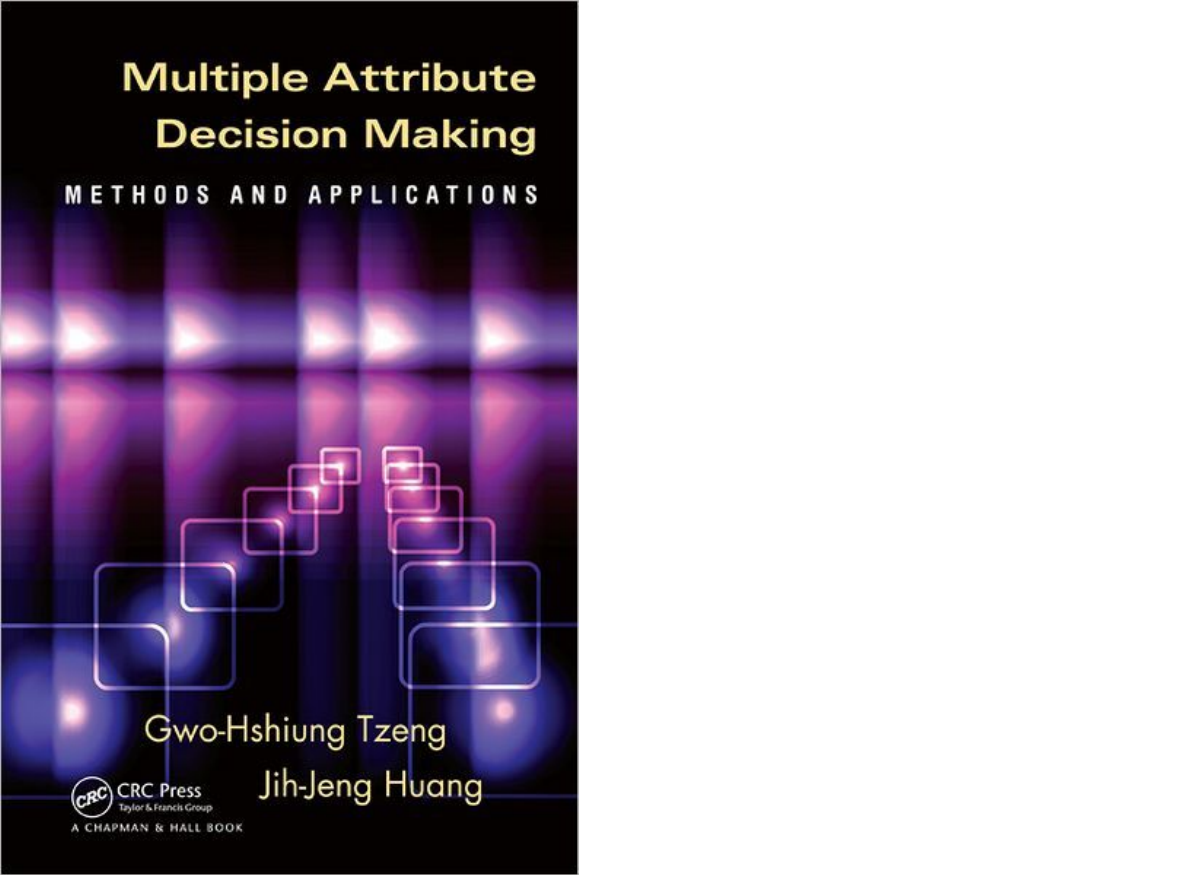
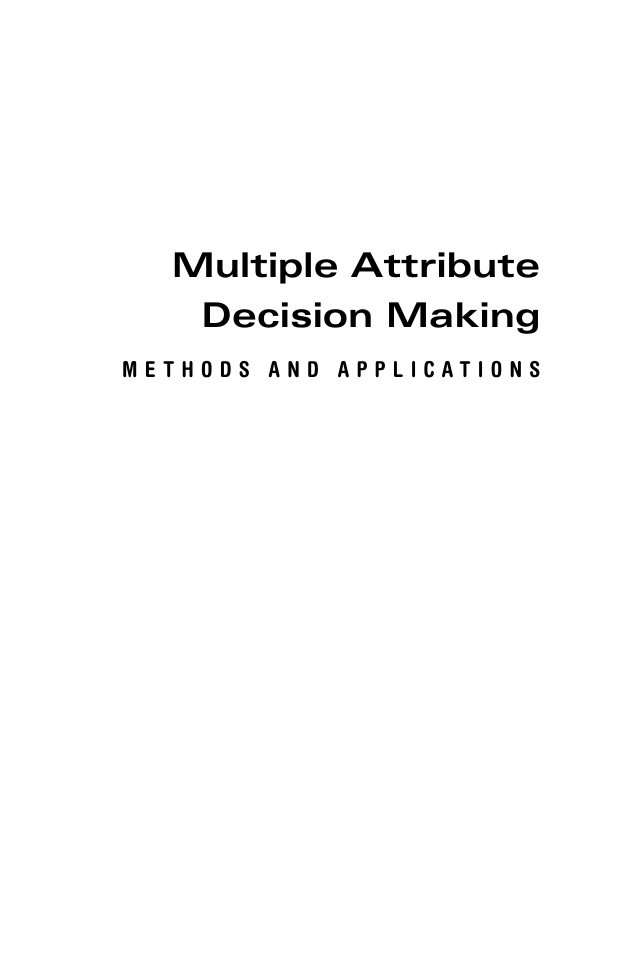

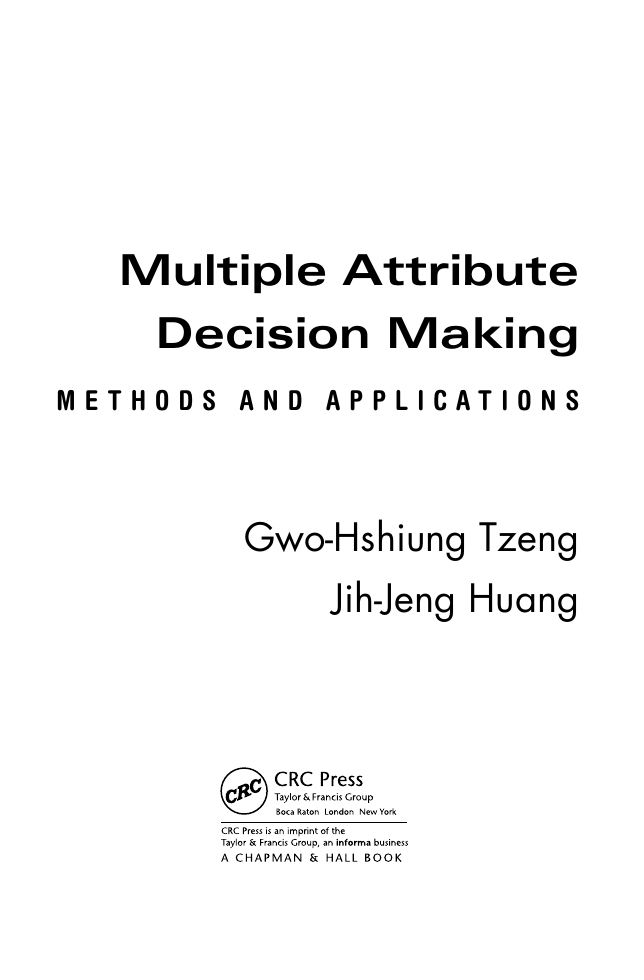

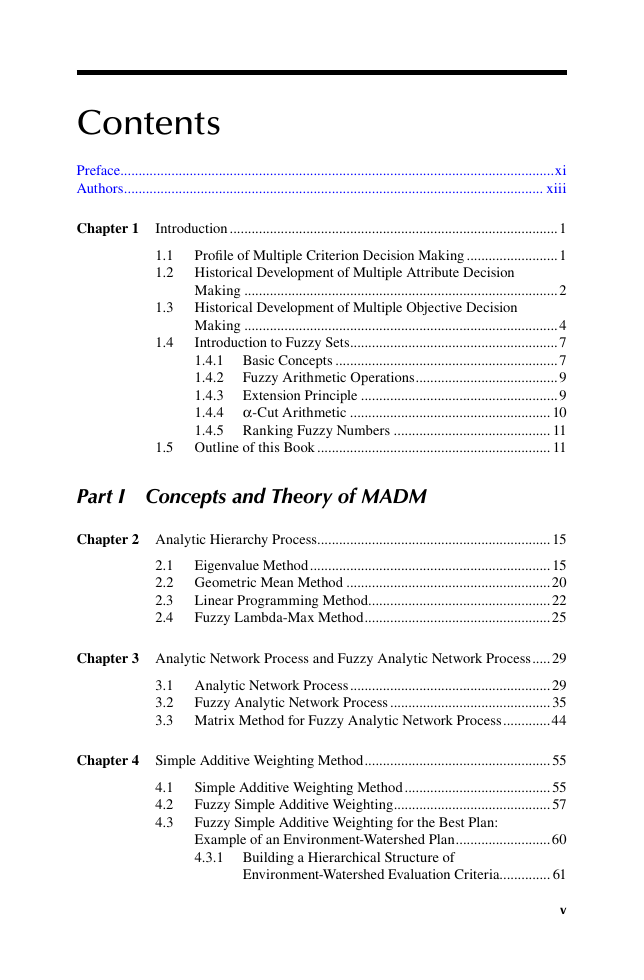
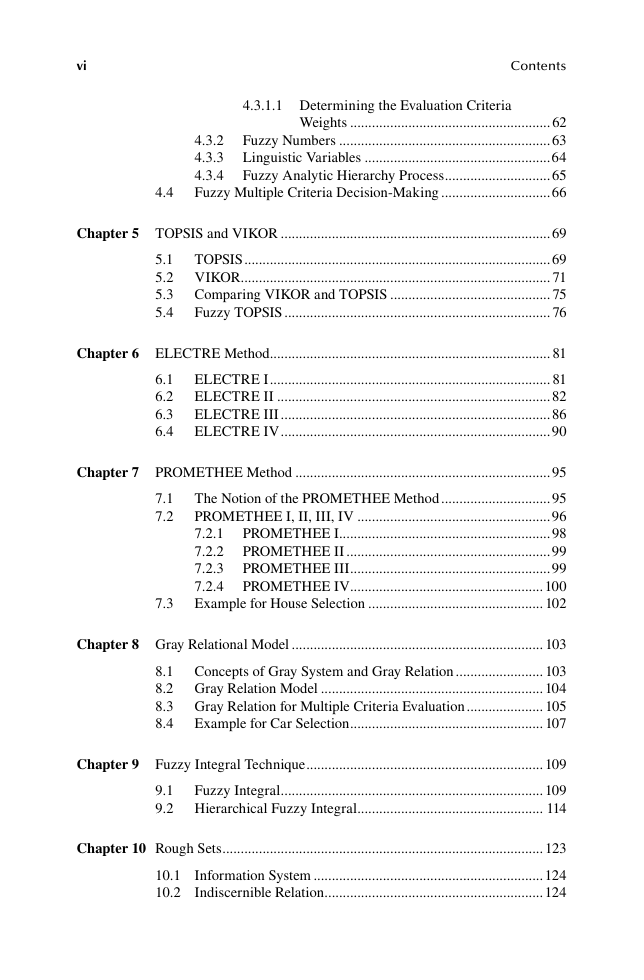









 2023年江西萍乡中考道德与法治真题及答案.doc
2023年江西萍乡中考道德与法治真题及答案.doc 2012年重庆南川中考生物真题及答案.doc
2012年重庆南川中考生物真题及答案.doc 2013年江西师范大学地理学综合及文艺理论基础考研真题.doc
2013年江西师范大学地理学综合及文艺理论基础考研真题.doc 2020年四川甘孜小升初语文真题及答案I卷.doc
2020年四川甘孜小升初语文真题及答案I卷.doc 2020年注册岩土工程师专业基础考试真题及答案.doc
2020年注册岩土工程师专业基础考试真题及答案.doc 2023-2024学年福建省厦门市九年级上学期数学月考试题及答案.doc
2023-2024学年福建省厦门市九年级上学期数学月考试题及答案.doc 2021-2022学年辽宁省沈阳市大东区九年级上学期语文期末试题及答案.doc
2021-2022学年辽宁省沈阳市大东区九年级上学期语文期末试题及答案.doc 2022-2023学年北京东城区初三第一学期物理期末试卷及答案.doc
2022-2023学年北京东城区初三第一学期物理期末试卷及答案.doc 2018上半年江西教师资格初中地理学科知识与教学能力真题及答案.doc
2018上半年江西教师资格初中地理学科知识与教学能力真题及答案.doc 2012年河北国家公务员申论考试真题及答案-省级.doc
2012年河北国家公务员申论考试真题及答案-省级.doc 2020-2021学年江苏省扬州市江都区邵樊片九年级上学期数学第一次质量检测试题及答案.doc
2020-2021学年江苏省扬州市江都区邵樊片九年级上学期数学第一次质量检测试题及答案.doc 2022下半年黑龙江教师资格证中学综合素质真题及答案.doc
2022下半年黑龙江教师资格证中学综合素质真题及答案.doc